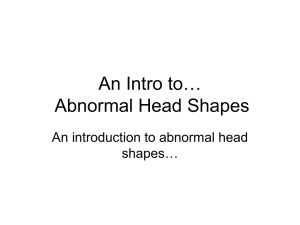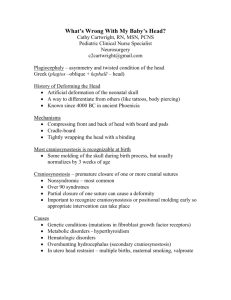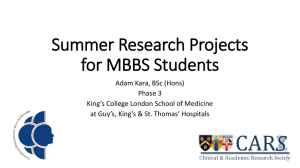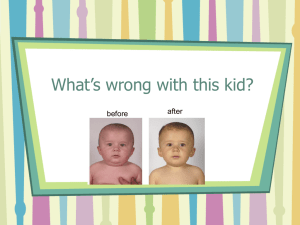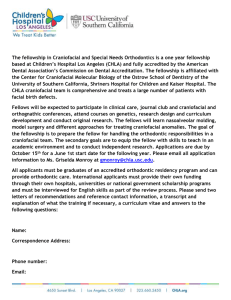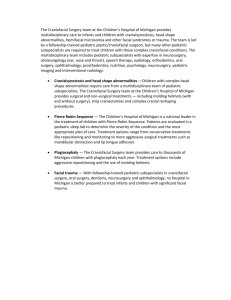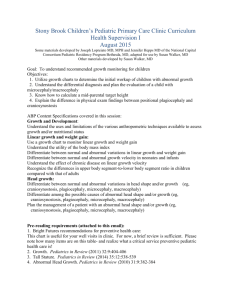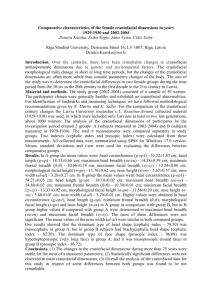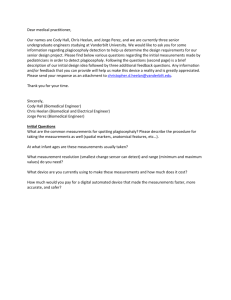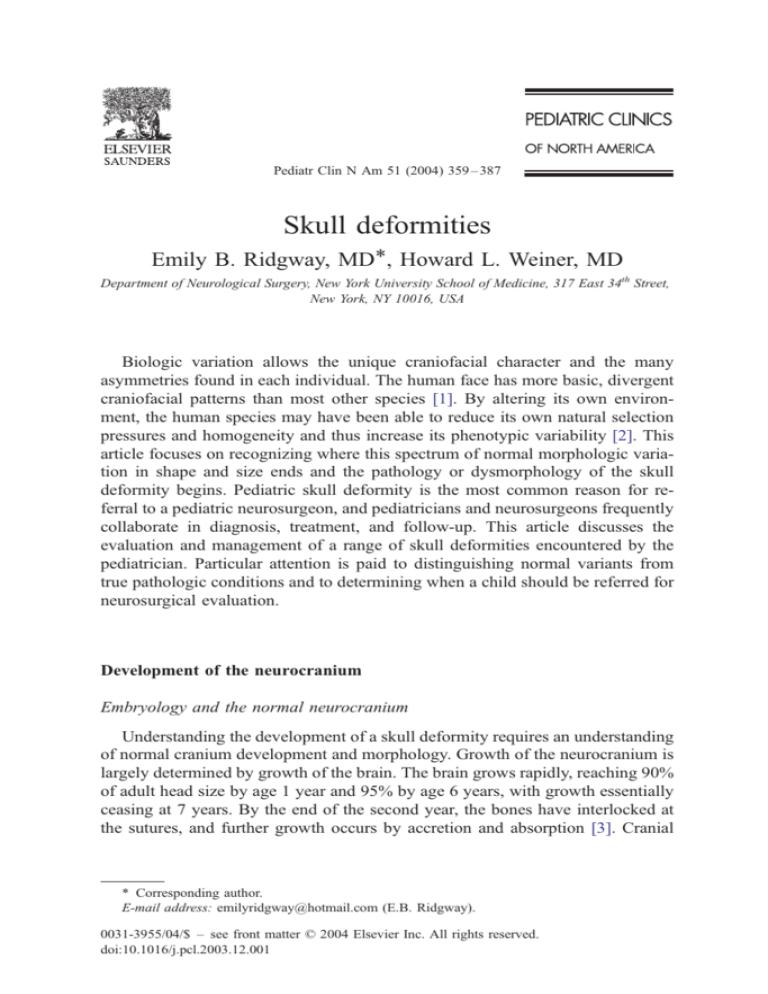
Pediatr Clin N Am 51 (2004) 359 – 387
Skull deformities
Emily B. Ridgway, MD*, Howard L. Weiner, MD
Department of Neurological Surgery, New York University School of Medicine, 317 East 34th Street,
New York, NY 10016, USA
Biologic variation allows the unique craniofacial character and the many
asymmetries found in each individual. The human face has more basic, divergent
craniofacial patterns than most other species [1]. By altering its own environment, the human species may have been able to reduce its own natural selection
pressures and homogeneity and thus increase its phenotypic variability [2]. This
article focuses on recognizing where this spectrum of normal morphologic variation in shape and size ends and the pathology or dysmorphology of the skull
deformity begins. Pediatric skull deformity is the most common reason for referral to a pediatric neurosurgeon, and pediatricians and neurosurgeons frequently
collaborate in diagnosis, treatment, and follow-up. This article discusses the
evaluation and management of a range of skull deformities encountered by the
pediatrician. Particular attention is paid to distinguishing normal variants from
true pathologic conditions and to determining when a child should be referred for
neurosurgical evaluation.
Development of the neurocranium
Embryology and the normal neurocranium
Understanding the development of a skull deformity requires an understanding
of normal cranium development and morphology. Growth of the neurocranium is
largely determined by growth of the brain. The brain grows rapidly, reaching 90%
of adult head size by age 1 year and 95% by age 6 years, with growth essentially
ceasing at 7 years. By the end of the second year, the bones have interlocked at
the sutures, and further growth occurs by accretion and absorption [3]. Cranial
* Corresponding author.
E-mail address: emilyridgway@hotmail.com (E.B. Ridgway).
0031-3955/04/$ – see front matter D 2004 Elsevier Inc. All rights reserved.
doi:10.1016/j.pcl.2003.12.001
360
E.B. Ridgway, H.L. Weiner / Pediatr Clin N Am 51 (2004) 359–387
anomalies thus develop most commonly within the prenatal period and in the
following period of skull growth. It is this period of development that must be
examined for further understanding the genetic and environmental causes of
craniosynostosis and the resulting abnormal skull morphology.
The neurocranium is embryologically divided into the vault (calvarium),
formed from membranous bone, and the basicranium, formed in cartilage. The
initial neurocranium development depends on the formation of the brain and its
surrounding membranes including the dural membrane. Brain absence has been
shown to result in acalvaria [4]. The initial surrounding membrane is derived of
mesoderm and neural crest ectomesenchmye and is subdivided into an inner
endomeninx and outer ectomeninx. The outer ectomeninx further subdivides into
an outer osteogenic layer in which the ossification centers form skull bones and
an inner layer of dura mater [5]. The inner endomeninx becomes the outer arachnoid layer and inner pia mater. The ossification centers form frontal, parietal,
squamous occipital, and squamous temporal bones, whereas the intervening areas
form fibrous sutures and fontanelles. The sutures generally fuse at the end of
the second year of life. The diamond-shaped anterior fontanelle, which is the
largest fontanelle (approximately 4 2.5 cm), normally closes at approximately
2.5 years of life or sooner. The triangular-shaped posterior fontanelle generally
closes at 2 to 3 months of life. The sphenoid (anterolateral fontanelle) and mastoid fontanelles (posterolateral fontanelle) are irregular and small and also generally close by 2 to 3 months of age (Figs. 1, 2)[3,5].
Defects occur in the completion of ossification, resulting in disorders such as
cranium bifidum, and in premature closure of the calvarial sutures. Premature
suture closure, or craniosynostosis, its resulting skull deformities, and means of
Fig. 1. (A) Major cranial sutures and bones. (B) Normal patterns of skull bone growth perpendicular
to sutures. (From Dufresne C, Carson B, Zinreich S. Complex craniofacial problems. New York:
Churchill Livingstone; 1992. p. 160; with permission.)
E.B. Ridgway, H.L. Weiner / Pediatr Clin N Am 51 (2004) 359–387
361
Fig. 2. Major cranial sutures and fontanelles. (From Texas Pediatric Surgical Associates, Houston,
Texas; with permission.)
distinguishing these deformities from positional or deformational skull deformities are considered in this article.
Causes of prematurely fused sutures
Genetic and environmental factors suspected of causing craniosynostosis have
been heavily investigated. In contrast to other craniofacial dysmorphology such
as oroclefting many craniosynostoses have been found to result from single-gene
mutations; environmental, teratogenic causes are more rare [5]. Of the genetic
mutations found to be responsible for craniosynostosis, mutations in the fibroblast growth factor receptors (FGFR 1, -2, -3) and the TWIST and MSX2 genes are
most commonly cited [5]. The rare environmental factors that have been linked
etiologically to craniosynostoses include rickets (caused by vitamin D deficiency,
resistance to vitamin D, chronic renal failure, or hypophosphatemia) and hyperthyroidism [5]. The teratogens that have been implicated in the causation of
craniosynostosis include phenytoin, retinoids, valproate, aminopterin/methotrexate, fluconazole, and cyclophosphamide [5]. Most recently, local intrauterine
factors related to constraint of the fetus have also been linked to cases of craniosynostosis and are deemed risk factors predisposing to craniosynostosis. These
factors include abnormal positioning in utero, overcrowding caused by multiple
pregnancy, oligohydramnios, and increased duration of the first stage of labor, all
with resulting increased fetal head constraint [5].
The effects of prematurely fused sutures on skull growth
Several theories have been proposed to explain the development of the
resulting skull deformity once a fused suture is present. In the nineteenth century,
362
E.B. Ridgway, H.L. Weiner / Pediatr Clin N Am 51 (2004) 359–387
Virchow explained that fused sutures act as barriers to the brain’s normal growth,
forcing the brain to expand in abnormal directions and thus creating a visible
skull deformity. He observed that, acting as the underlying and expanding matrix
of the skull, the brain and its development and growth directly and strongly affect
skull growth and shape. He noted that when a suture is synostosed, the rapid force
of brain growth is restrained and altered because the brain cannot expand in the
direction of the synostosed suture. The brain and the skull shapes are thus forced
in dimensions perpendicular to the fused suture as a consequence of a compensatory growth along the adjacent open sutures. This theory is still commonly
accepted today [5].
Normal variations in cranial morphology versus dysmorphology
The normal human cranial shape demonstrates diversity related to both genetic
and environmental influences and ranges from the extremes of the long, narrow
dolicocephalic head with a cranial width-to-length index of less than 0.75, to the
mesocephalic head with a cranial width-to-length index between 0.75 and 0.80,
Fig. 3. Extremes in human form head shape (brachycephaly, mesocephaly, and dolichocephaly).
(From Mooney MP, Siegel MI. Understanding craniofacial anomalies. New York: Wiley-Liss; 2002.
p. 4; with permission.)
E.B. Ridgway, H.L. Weiner / Pediatr Clin N Am 51 (2004) 359–387
363
and to the wide, short, globular brachycephalic head with a cranial width-tolength index of greater than 0.80 (Fig. 3) [5]. It superimposed upon this spectrum
of normal cranial morphology that dysmorphology may occur.
Cranial dysmorphology classifications
Craniofacial dysmorphology has been divided into the three categories of malformations, deformations, and disruptions, depending on the earliest or primary
defect in morphogenesis. This division has been created to elucidate further
whether all of the anomalies can be traced to one single event or time in morphogenesis and, thus, to aid physicians in understanding the cause and in counseling families about recurrence risk, treatment, and prevention recommended for
each anomaly.
Malformations occur during the first 8 weeks of pregnancy during embryogenesis of a specific organ, result from genetic, environmental causes or a
combination of the two, and are associated with higher recurrence rates than the
environmentally related disruptions and deformations. Disruptions result from
destructive processes that occur after organogenesis to a morphogenetically
normal tissue or organ (eg, amniotic banding resulting in a cleft lip). Disruptions
are thought to be primarily environmental in origin and thus have low recurrence
rates [5]. Deformations occur after embryogenesis and result from nondisruptive
mechanical forces causing abnormal formations or distortions of morphogenetically normal body parts (eg, positional plagiocephaly). Deformations may be
caused by direct local uterine or postnatal positional factors, may resolve with an
altered environment, and are associated with low recurrence rates (Table 1).
Depending on their severity and developmental timing, these malformations,
deformations, and disruptions can result in consistent patterns of multiple
anomalies, which are further classified as either syndromes or sequences. A
sequence is a pattern of multiple abnormalities resulting from a single anomaly or
mechanical factor, such as an amniotic band sequence or torticollis-plagiocephaly
sequence. In contrast, a syndrome is a pattern of anomalies that are pathogeTable 1
Comparative features of the three types of dysmorphogenesis
Features
Malformations
Deformations
Disruptions
Time of occurrence
Level of disturbance
Perinatal mortality
Phenotypic variability
Spontaneous correction
Postural correction
Surgical correction
Relative recurrence rate
Approximate frequency in newborns
Embryonic
Organ
+
Moderate
Fetal
Region
Embryonic
Area
+
Extreme
+
High
2% – 3%
Mild
+
+
±
Low
1% – 2%
+
Extremely low
1% – 2%
From Mooney PM, Siegel MI. Understanding craniofacial anomalies. New York: Wiley-Liss; 2002;
with permission.
364
E.B. Ridgway, H.L. Weiner / Pediatr Clin N Am 51 (2004) 359–387
netically related but not known to represent a single sequence, such as Apert’s
syndrome [5]. The discussion of syndromes is relevant when reviewing craniosynostosis, because cases of craniosynostosis are classified as syndromic or
nonsyndromic. These differentiations are important, because the treatment, associated findings, and prognosis differ between syndromic and nonsyndromic
craniosynostosis. Nonsyndromic cases are generally single-suture synostoses involving the metopic, sagittal, or coronal sutures. Syndromic cases include Apert’s
syndrome, Crouzon’s syndrome, and Pfeiffer’s syndrome, as discussed later.
Craniosynostosis classification schemes
The classifications for craniosynostoses have evolved over time as the understanding of the causes of various craniosynostoses has grown. The first
classification scheme was proposed by Virchow in 1851 and is a descriptive, morphologic nomenclature based on head shape and size (Table 2) [5]. These terms
are still widely used by physicians and surgeons for describing an anomaly and in
planning the recommended surgical intervention. This scheme, however, is solely
descriptive and does not make important distinctions that affect prognosis and
recurrence, such as distinguishing between identical-appearing deformational or
syndromic-related anomalies. A second classification scheme soon evolved as a
result of observations of recurrent patterns of associated anomalies and repetitively observed recurrences among families suggesting a genetic cause. These
anomalies also occurred with variations in the phenotypic distinctions among the
disorders, making the purely descriptive classification scheme less clear. This
second scheme attempted to reconcile the descriptive terminology described by
Virchow with the newly emerging genetic understanding of the anomalies,
although the specific genetics were not yet understood (Table 3) [5]. More
Table 2
Morphologic nomenclature in common usage
Term
Meaning
Suture Involved
Dolichocephaly
Scaphocephaly
Acrocephaly
Long head
Keel-shaped head
Pointed head
Brachycephaly
Oxycephaly
Turricephaly
Trigonocephaly
Plagiocephaly
Kleeblattschadel
Craniofacial dysostosis
Short head
Tower-shaped head
Tower-shaped head
Triangular-shaped head
Asymmetric head
Cloverleaf skull
Midface deficiency
Sagittal suture
Sagittal suture
Coronal suture, Coronal/lambdoid,
or all sutures
Coronal suture
Coronal/lamboid or all sutures
Coronal suture
Metopic suture
Unilateral lambdoid or positional
Multiple but not all sutures
Craniosynostosis with involvement
of cranial base sutures
From Mooney PM, Siegel MI. Understanding craniofacial anomalies. New York: Wiley-Liss; 2002;
p. 12; with permission.
E.B. Ridgway, H.L. Weiner / Pediatr Clin N Am 51 (2004) 359–387
365
Table 3
Commonly used clinical genetic classifications
Diagnostic Category
Name of Disorder
Cause
Isolated craniosynostosis
Morphologically described
Syndromic Craniosynostosis
Antler-Bixler syndrome
Apert’s syndrome
Unknown, uterine constraint,
or FGFR3 mutation
Unknown
Usually one of two mutations
in FGFR2
Mutation in GFGR2 or FGFR3
Mutation in TWIST heterogenous
Unknown
Unknown gene at Xp22
Numerous different mutations
at FGFR2
Mutation in FGFR3
Baere-Stevenson syndrome
Bailler-Gerold syndrome
Carpenter’s syndrome
Craniofrontonasal dysplasia
Crouzon’s syndrome
Crouzonomesodermoskeletal
syndrome
Jackson-Weiss syndrome
Muenke’s syndrome
Pfeiffer’s syndrome
Saethre-Chotzen syndrome
Shprintzen-Goldberg syndrome
Mutation in FGFR2
Mutation in FGFR3
Mutation in FGFR1 or numerous
mutations in FGFR2
Mutation in TWIST
Mutation in FBFN1
From Mooney PM, Siegel MI. Understanding craniofacial anomalies. New York: Wiley-Liss; 2002;
p. 13; with permission.
recently, as the actual genes responsible for the best-defined craniosynostosis
syndromes have been identified, a third scheme of classification based on
molecular genetics has developed. The three systems are complementary, because
no single system yet describes completely the molecular pathogenesis, phenotype, prognosis, and recurrence risk.
The pediatrician’s role in identifying cranial vault anomalies
Approximately 2% of infants are born with some extrinsically caused
deformity; the remainder of deformities result from an intrinsic abnormality
[6]. A rough approximation of craniosynostosis incidence is 0.014 to 0.048 cases
per 1000 births or 1 in 2100 to 3000 newborns [5,7]. A pediatrician is the first
physician to examine a child and offers the first opportunity for intervention.
Thus, pediatrician has a responsibility to be aware of normal variations in cranial
shape and size, the clinical findings characteristic of deformational and craniosynostotic skull shapes, and the differences between the two (Table 4).
If a skull deformity is present, the physical examination and clinical history
are the most helpful and revealing pieces of information in the child’s evaluation.
The pediatrician should be attentive to questioning regarding developmental
milestones, irritability, headaches, emesis, and visual complaints. On the exami-
366
Type
Epidemiology
Skull Deformity
Clinical Presentation
Sagittal
Most common CSO affecting
a single suture, 80% male
18% of CSO, more common
in females
Associated with Apert’s syndrome
(with syndactly) and Crouzon’s
disease which includes abnormal
sphenoid, orbital, and facial bones
(hypoplasia of the midface)
10% – 20% of CSO, M:F ratio 4:1
Dolicocephaly or scaphocephaly
(boat-shaped)
Unilateral: plagiocephaly
Bilateral: brachycephaly,
acrocephaly
Frontal bossing, prominent occiput, palpable keel ridge, OFC normal and
reduced biparietal diameter
Unilateral: flattened forehead on affected side, flat cheeks, nose deviation on
normal side, higher supraorbital margin leads to harlequin sign on radiograph
and outward rotation of orbit may result in amblyopia
Bilateral: broad, flattened forehead. In Apert’s syndrome accompanied by
syndactyly and in Crouzon’s disease by hyploplasia of the midface and
progressive proptosis
Lambdoid/occipital plagiocephaly;
right side affected in 70% of cases.
Unilateral: flattening of occiput, indentation along synostotic suture, bulging
of ipsilateral forehead leading to rhomboid skull, ipsilateral ear is anterior
and inferior
Bilateral: brachycephaly with bilateral anteriorly and inferiorly displaced ears
Pointed forehead and midline ridge, hypotelorism,
Coronal
Lambdoid
Metopic
Multiple
Association with 19p chromosome
abnormality
Trigoncephaly
Oxycephaly
Tower skull with undeveloped sinuses and shallow orbits, and elevated
intercranial pressure
E.B. Ridgway, H.L. Weiner / Pediatr Clin N Am 51 (2004) 359–387
Table 4
Epidemiology and clinical characteristics of the common craniosynostoses
E.B. Ridgway, H.L. Weiner / Pediatr Clin N Am 51 (2004) 359–387
367
nation, special attention should be paid to the alertness of the patient, the head
circumference, the pupils and fundoscopic evaluation for papilledema, the
fontanelles, and the shape and characteristics of the deformity. The pediatrician
should schedule frequent examinations, which would include photographing the
child and following the head circumference and developmental milestones. The
pediatrician should refer appropriate cases to a neurosurgeon or craniofacial team.
Although these diagnoses may be rare, their clinical significance requires diagnosis and referral for further evaluation and treatment recommendations.
Distinguishing true craniosynostosis from birth molding and positional or
deformational lambdoid plagiocephaly
Differentiating between birth molding, positional plagiocephaly without synostosis, and true synostosis is one of the first distinctions to be made and properly
understood. In making this distinction, the history and physical examination
provide the most valuable information. Normal birth molding results in findings
that resolve within hours to weeks of birth without intervention and is clinically
different in timing of presentation and quality from positional or deformational
lambdoid plagiocephaly. Characteristically, passage of the infant through the birth
canal results in pressure in the anteroposterior dimensions and less in the side-toside dimension. The calvarium thus grows longer in the vertical dimension as the
parietal bones rise away from the skull base and the frontal and occipital bones
slip under the anterior and posterior borders of the parietal bones, respectively.
This overriding quality is often palpable and visible at birth but resolves, unlike
synostosis cases, which are present at birth but progress, or deformational cases,
which are generally not present at birth but develop during infancy.
Deformational plagiocephaly results from local pressure on a specific region
of the skull, typically in one occipital region resulting in occipital/lambdoid
plagiocephaly or the so-called ‘‘lazy lambdoid.’’ The clinical finding of lambdoid
plagiocephaly is becoming more frequently seen by pediatric neurosurgeons and
in m any practices is now the most common reason for referral to a pediatric
neurosurgeon. Nonsynostotic plagiocephaly has been reported as occurring in up
to 48% of healthy neonates [8]. This high incidence and the clinical similarities to
actual lambdoid synostosis have fueled a renewed and widespread interest in the
topic of lambdoid plagiocephaly and its treatment. The point of referral to a
pediatric neurosurgeon in these cases is making the distinction between a true
synostosis and a deformational or positional plagiocephaly without synostosis. At
the New York University School of Medicine, it has been observed that cases of
true lambdoid craniosynostosis are exceedingly rare and that almost all cases of
lambdoid plagiocephaly are deformational and rarely require surgical intervention. This finding has also been supported by results of a study at Boston
Children’s Hospital that found that true lambdoid synostosis accounts for only
2.3% of all synostosis cases [8]. This differentiation is best made by acquiring a
complete clinical history and physical examination and rarely requires further
studies (Table 5).
368
E.B. Ridgway, H.L. Weiner / Pediatr Clin N Am 51 (2004) 359–387
Table 5
Pertinent features and differential diagnosis of plagiocephaly
Unilambdoid
Synostosis
Unicoronal
Synostosis
Ipsilateral ear position Anterior
Flattening
Ipsilateral occipitoparietal
Posterior-inferior
Ipsilateral
occipitoparietal
Vertex view
Suture
Trapezoid
Lambdoid fusion,
ridging
Anterior-superior
Ipsilateral frontal
with orbital rim
elevation
Trapezoid
Coronal fusion,
ridging
Finding
Bossing
Skull base (3D-CT)
Posterior Plagiocephaly
Without Synostosis
Parallelogram
No lambdoid fusion, may
have fibrous union,
no ridging
Ipsilateral frontal,
contralateral occipital
No tilt, no midline deviation
Contralateral parietal, Contralateral frontal
ipsilateral mastoid
Tilt, posterior fossa
Anterior fossa
deviation off midline deviation off midline
From Lin KY, Ogle RC, Jane JA. Craniofacial surgery: Science and Surgical Technique. Philadelphia:
W.B. Saunders; 2002; p. 243.
Risk factors for deformational plagiocephaly that can be identified in the
patient’s history include intrauterine crowding and positioning, decreased mobility in patients with developmental delay, mental retardation, prematurity or
chronic illness, and cases of intentional positioning or abnormal posturing such as
torticollis and congenital disorders of the cervical spine [5]. For example, many
postulate that the recent increase in the previously rare diagnosis of lambdoid
plagiocephaly might be attributed to a recommendation of the 1992 American
Academy of Pediatrics ‘‘Back to Sleep’’ campaign [9]. The campaign advocated
that newborns be placed in a supine sleeping position, sometimes with a
foam wedge to tilt the head to one side to decrease aspiration and the risk of
sudden infant death syndrome. Parents of patients with deformational plagiocephaly classically report that their child nearly always lies in one position with
the head turned to one side. This history in addition to the physical examination nearly always allows one to distinguish deformational plagiocephaly from
true craniosynostosis.
There are several important points to review regarding the physical examination in suspected synostosis. In cases of true synostosis, a palpable bony prominence or ridge is often appreciated over the suspected suture, and gentle firm
pressure on either side of the suture by the thumbs fails to cause relative movement of the bones on either side of the suture. In contrast, in cases of positional
plagiocephaly, there is no sutural ridging, and movement of the bones may be
appreciated. The overall head shape is also different. In cases of deformational
plagiocephaly, a parallelogram shift in the cranial shape occurs, resulting in a
rhomboid-shaped skull characterized by a flattening of the occiput with an
associated bulging of the ipsilateral forehead with the ipsilateral ear sheared
anteriorly and inferiorly to the contralateral ear. The contralateral orbit and forehead may also be flattened. These findings are unique to positional plagiocephaly,
E.B. Ridgway, H.L. Weiner / Pediatr Clin N Am 51 (2004) 359–387
369
unlike the trapezoid-shaped skull with an ipsilateral mastoid bulge, posterior
displacement of the ear, and contralateral occipital bossing that develop in true
lambdoid synostosis (Figs. 4, 5). In rare, difficult cases when the examination and
history are not diagnostic, a skull radiograph is generally the best first diagnostic
study to confirm positional plagiocephaly and to demonstrate the patency of the
suture. In cases of synostosis, the skull radiograph may show a sclerotic margin.
On confirmation of deformational plagiocephaly, it is necessary to diagnose
the cause of the skull deformity and to recommend appropriate treatment to be
followed closely by a period of frequent serial evaluations. For cases of infants
with poor mobility, repositioning for mild cases or molding-helmet therapy in
more severe cases is appropriate. Repositioning has been shown to be effective in
improving the deformity in approximately 85% of mild cases. For severe cases or
for mild cases that do not improve with repositioning, helmet therapy may be
advised [10]. The authors have found that all helmets are equally efficacious and
safe and that, despite commercial claims, no one product is superior. One such
helmet is the DOC Band (Cranial Technologies Inc., Tempe, Arizona), the first
helmet for which approval by the Food and Drug Administration was sought; it is
a plastic helmet with foam lining that weighs 6 oz and can be used on infants
ranging from 3 to 24 months of age with plagiocephaly, scaphocephaly, or
brachycephaly that does not result from true synostosis.
The aim of any helmet is to place mild pressure on prominent areas of the skull
while allowing room for flattened areas. The helmet is worn 23 hours per day,
Fig. 4. Differences in head shape from vertex view (arrows indicate direction of compensatory growth
vectors). (A) Positional molding produces parallelogram-shaped head. (B) Unilambdoid synostosis
produces trapezoid-shaped head. (From Gruss JS, Ellenbogen RG, Whelan MF. Lambdoid synostosis
and posterior plagiocephaly. In: Lin KY, Ogle RC, Jane JA, editors. Craniofacial surgery: science and
surgical technique. Philadelphia: WB Saunders; 2002. p. 242.)
370
E.B. Ridgway, H.L. Weiner / Pediatr Clin N Am 51 (2004) 359–387
E.B. Ridgway, H.L. Weiner / Pediatr Clin N Am 51 (2004) 359–387
371
and the children are followed closely for weekly or biweekly adjustments of the
helmet, documentation of improvement, and examination of the scalp for areas of
irritation. If no improvement ensues, further studies or surgery may be contemplated for severe deformities. Mild to moderate deformity resulting from synostosis or deformation rarely warrant surgical correction, because hair growth
later covers the defect satisfactorily. At the New York University School of Medicine, satisfactory improvement is typically seen with repositioning and helmet
therapy, and surgery for lambdoid plagiocephaly is not indicated. Further, it is
important to counsel parents that no evidence supports operating on a singlesuture stenosis or plagiocephaly to prevent intellectual impairment or developmental delay, and that an intervention is directed at cosmetic improvement [8].
For children with torticollis, treatment of the torticollis is recommended with
or without the addition of helmet therapy depending on the severity of the deformity. Torticollis and nonsynostotic occipital plagiocephaly reportedly occur in
1 in 300 live births [8]. Torticollis is defined as a form of dystonia resulting in a
failure to control the head position [3]. It may be congenital or of acquired
muscular origin caused by the limited room in the uterus during gestation, muscle
spasm, hematoma within the muscle, a cerebellar tumor, or atlantoaxial rotatory
subluxation but consistently results in a tightened, shortened sternocleidomastoid
muscle on the affected side causing an affected infant to tilt the head to the tight
side and turn away [3]. Torticollis is often not detected at birth but is observed
during infancy as the neck begins to lengthen and the head tilting becomes more
pronounced, with a preferred resting position and possible resulting plagiocephaly. Treatment for torticollis includes early involvement with a physical
therapist for neck strengthening and stretching, head-turning, and repositioning
exercises. The child may benefit also from resting in the prone position, avoiding
positioning such as in walkers or jumpers where stress is placed on the neck, and
propping the neck in straight alignment. If no improvement ensues within 1.5 or
2 years, further treatment may be recommended, including options such as local
botulinum toxin injection, endoscopic tenotomy or bipolar Z-plasty of the
sternocleidomastoid, selective rhitozotomy, or spinal accessory nerve section
followed by placement in collar [3,11]. The authors have found that surgical
intervention is needed in only rare cases, and more than 95% of cases of torticollis are successfully treated with physical therapy.
True craniosynostosis: nonsyndromic and syndromic craniosynostosis
Of all patients treated for craniosynostosis disorders, approximately one sixth
are affected by syndromic craniofacial malformations [12]. Syndromic cases of
Fig. 5. Differences between positional molding (A) and unilamdoid synostosis (B). (From Gruss JS,
Ellenbogen RG, Whelan MF. Lambdoid synostosis and posterior plagiocephaly. In: Lin KY, Ogle RC,
Jane JA, editors. Craniofacial surgery: science and surgical technique. Philadelphia: WB Saunders;
2002. p. 242.)
372
E.B. Ridgway, H.L. Weiner / Pediatr Clin N Am 51 (2004) 359–387
craniosynostosis represent a unique group of patients with associated morphologic and functional abnormalities not seen in simple nonsyndromic patients who
may experience isolated craniosynostosis. The separate abnormalities experienced by syndromic patients evolve at different times during the patients’ lives
and require treatment by physicians trained in different specialties. Of neurosurgical interest is the increased frequency of hydrocephalus, elevated intracranial
pressure (ICP), and Chiari malformations that are uncommon in nonsyndromic
craniosynostosis [12]. It is the belief at the New York University School of
Medicine that it is imperative that these patients be treated and followed by a
multidisciplinary craniofacial team including a pediatric neurosurgeon, plastic
surgeon, ophthalmologist, neurologist, otolaryngologist, orthodontist, psychologist, geneticist, and social worker to make the proper diagnosis and to attend
properly to all the developing issues that these children encounter [12]. The most
common nonsyndromic craniosynostoses include metopic, sagittal, and coronal
craniosynostosis. The most common syndromes including craniosynostosis are
Apert’s syndrome, Crouzon’s syndrome, and Pfeiffer’s syndrome.
Metopic synostosis: trigonocephaly
The metopic suture is the first suture to close and normally does so just after
birth. Premature closure of the metopic suture results in trigonocephaly, a characteristic pointed forehead with a midline metopic ridge deformity from the
Fig. 6. Metopic synostosis with trigonocephaly. (From Dufresne C, Carson B, Zinreich S. Complex
craniofacial problems. New York: Churchill Livingstone; 1992. p. 170; with permission.)
E.B. Ridgway, H.L. Weiner / Pediatr Clin N Am 51 (2004) 359–387
373
Fig. 7. Metopic synostosis. (From Texas Pediatric Surgical Associates, Houston, Texas; with
permission.)
bossing of the central frontal bone (Figs. 6, 7). If the premature fusion also
includes the frontonasal suture, hypotelorism results. More severe cases also
display severe constriction of the forehead with resulting symmetric expansion
of the skull posterior to the coronal sutures. This diagnosis is usually easily
made by the experienced physician and confirmed with radiograph or CT scan.
In raren case, the underlying brain is malformed with both arrhinecephaly and
holoprosencephaly observed. These rare cases with associated frontal lobe malformations are associated with mental retardation. Treatment of metopic suture
synostosis depends on the severity of the case. Mild cases with only visible or
palpable suture often do not require surgical intervention, and the ridge often
becomes less noticeable as the child grows. Previously, some neurosurgeons have
advocated burring down the keel or removing the keel from the coronal suture to
the frontonasal suture; most, including those at the New York University School
of Medicine, favor a bilateral cranial vault remodeling procedure.
Sagittal synostosis: scaphocephaly
Sagittal synostosis is the most common craniosynostosis, with a birth
prevalence of 1 in 5000 [13]. Sagittal synostosis is identified by the characteristic
dolichocephaly or scaphocephaly (ie, a. boat-shaped skull with a markedly
reduced biparietal diameter but increasing head circumference) that crosses
growth percentile lines during the first few months of life. The head is elongated
with frontal bossing and an occipital knob or bullet protuberance (Figs. 8 –11).
374
E.B. Ridgway, H.L. Weiner / Pediatr Clin N Am 51 (2004) 359–387
Fig. 8. Sagittal synostosis with scaphocephaly. (From Dufresne C, Carson B, Zinreich S. Complex
craniofacial problems. New York: Churchill Livingstone; 1992. p. 189; with permission.)
Frequently, a palpable ridge can be appreciated along the longitudinal midline
sagittal suture between the anterior fontanelle and junction of the lambdoid
sutures. Sagittal synostosis is more common in males (80%) [13]. As in metopic
synostosis, focal neurologic deficits and elevated ICP are rare. Mental retardation
is even less common [6].
Fig. 9. Sagittal synostosis with scaphocephaly. (From Dufresne C, Carson B, Zinreich S. Complex
craniofacial problems. New York: Churchill Livingstone; 1992. p. 170; with permission.)
E.B. Ridgway, H.L. Weiner / Pediatr Clin N Am 51 (2004) 359–387
375
Fig. 10. Sagittal synostosis with scaphocephaly. (From Dufresne C, Carson B, Zinreich S. Complex
craniofacial problems. New York: Churchill Livingstone; 1992. p. 188; with permission.)
Surgical treatment by a neurosurgeon with any of the many variations of the
classic linear strip craniectomy, including endoscopic strip craniectomy, excising
the sagittal suture from anterior to the coronal suture to posterior to the lambdoid
suture, is generally recommended within the first 3 to 6 months of life [14]. It is
necessary that the excised strip be at least 3 cm in width, because infants have
tremendous osteoblastic potential and reossification across the channel and
recurrence may occur within weeks if the craniectomy is not sufficiently wide
[6]. If diagnosis or recurrence occur after 6 months, a more formal cranial vault
Fig. 11. Sagittal synostosis surgery. (From Texas Pediatric Surgical Associates, Houston, Texas;
with permission.)
376
E.B. Ridgway, H.L. Weiner / Pediatr Clin N Am 51 (2004) 359–387
remodeling procedure is necessary, which generally requires a team consisting of
a pediatric neurosurgeon and a craniofacial surgeon for optimal results.
Coronal synostosis: plagiocephaly, brachycephaly
Coronal synostosis is typically unilateral and accounts for approximately 18%
of craniosynostosis. It is more common in females [3,15]. It is also the most
common synostosis to be associated with a syndrome, typically when it is
bilateral. Sixty-one percent of all coronal cases are sporadic [15]. Unilateral
coronal synostosis results in plagiocephaly with the characteristic concave
flattening of the forehead and of the elevated supraorbital margin on the affected
side and bossing of the frontal bone on the opposite side. This distortion results
in a characteristic finding on coronal radiographs called the harlequin sign
(Figs. 12 – 14). The deformity often includes the supraorbital ridge and frontal
bone and thus affects the orbital position, resulting in outward deviation of the
orbit on the abnormal side and amblyopia. This orbital asymmetry is often the
most disturbing aesthetic deformity [6]. If untreated, the tip of the nose may also
deviate toward the unaffected side, with the root deviating to the ipsilateral side,
and the cheeks may become flattened. Unilateral coronal synostosis is infrequently associated with increased ICP or a congenital malformation. Bilateral
coronal synostosis results in brachycephaly with a broad, flattened forehead and
Fig. 12. Unilateral cranial synostosis resulting in plagiocephaly. (From Dufresne C, Carson B,
Zinreich S. Complex craniofacial problems. New York: Churchill Livingstone; 1992. p. 173;
with permission.)
E.B. Ridgway, H.L. Weiner / Pediatr Clin N Am 51 (2004) 359–387
377
Fig. 13. Unilateral cranial synostosis resulting in plagiocephaly. (From Dufresne C, Carson B, Zinreich
S. Complex craniofacial problems. New York: Churchill Livingstone; 1992. p. 173; with permission.)
wide, foreshortened cranium (Figs. 15, 16). The orbital depth is frequently
decreased, resulting in exorbitism. It is generally seen in craniofacial dysmorphism in syndromic craniosynostosis with multisuture synostosis.
Previously, coronal synostosis was treated with simple linear craniectomy,
with poor results. Presently, the treatment of choice is cranial vault remodeling
and fronto-orbital advancement. Surgical correction is usually best accomplished
by a craniofacial team including a neurosurgeon and plastic surgeon [15]. It is
also necessary that a craniofacial group evaluate patients suspected of having
coronal synostosis, because coronal synostosis is the most commonly involved
suture found in syndromic craniosynostosis.
Multisuture synostosis: oxycephaly
A short and narrow head shape characterizes multisuture synostosis. The most
commonly affected sutures are the sagittal and coronal sutures. In some cases, all
of the sutures except the metopic suture are affected, resulting in a condition
described as Kleeblattschadel or cloverleaf skull with a characteristic frontal
telescoping of the skull referred to as craniotelecephaly. ICP is generally elevated,
and the frequency of mental retardation is high. Multisuture synostosis with
elevated ICP should be treated on diagnosis to avoid further neurologic damage
[15,16]. Surgery should be performed with a craniofacial team including a
378
E.B. Ridgway, H.L. Weiner / Pediatr Clin N Am 51 (2004) 359–387
Fig. 14. (A, B) Unilateral cranial synostosis resulting in plagiocephaly. (C) Lambdoid plagiocephaly
with coronal synostosis. (D) Lambdoid plagiocephaly without coronal synostosis. (From Dufresne C,
Carson B, Zinreich S. Complex craniofacial problems. New York: Churchill Livingstone; 1992.
p. 172; with permission.)
neurosurgeon and a plastic surgeon and typically consists of formal cranial vault
remodeling and fronto-orbital advancement.
Crouzon’s syndrome
Crouzon’s syndrome is an autosomal dominant syndrome with an incidence of
1 in 25,000 births. Mutations in the FGFR2 gene have been found in more than
half of studied affected subjects, and the specific gene for the syndrome has been
mapped to chromosome 10q26 region [15]. Crouzon’s syndrome is characterized
by a broad variability in the severity of craniosynostosis with the coronal sutures
nearly always involved (95% of cases), mostly in association with the sagittal and
E.B. Ridgway, H.L. Weiner / Pediatr Clin N Am 51 (2004) 359–387
379
Fig. 15. Bicoronal synostosis with brachycephaly. (From Dufresne C, Carson B, Zinreich S. Complex
craniofacial problems. New York: Churchill Livingstone; 1992. p. 170; with permission.)
lambdoid sutures (75% of cases) or only the sagittal suture (20% of cases) [15].
Brain malformations are infrequent, and mental retardation is rare, distinguishing
this syndrome from other syndromes with similar craniofacial features. The
craniosynostosis is associated with a marked shortening in the depth of the anterior cranial fossa with orbital roof hypoplasia and advancement of the posterior wall of the orbits, all which result in the characteristic and severe ocular
proptosis characteristic of the syndrome with its associated secondary exposure
keratitis and conjunctivitis. Additional prominent features are midface retrusion,
conductive hearing loss in half of the patients, mandibular overjet with an anterior
overbite, and a small nasopharnyx requiring mouth breathing (Fig. 17).
Apert’s syndrome
Apert’s syndrome is also an autosomal dominant syndrome with features
similar to Crouzon’s syndrome that results from a mutation in the FGFR2 gene
and has an incidence of 1 in 55,000 births [17,18]. It is similarly characterized by
craniosynostosis, most commonly involving bilaterally fused coronal sutures,
but mental retardation and underlying brain malformations, including corpus
callosum agenesis, cortical atrophy, or hydrocephalus, are more common than in
Crouzon’s syndrome [15,18]. The syndrome is most easily distinguished from
380
E.B. Ridgway, H.L. Weiner / Pediatr Clin N Am 51 (2004) 359–387
Fig. 16. Bicoronal synostosis surgery. (From Texas Pediatric Surgical Associates, Houston, Texas;
with permission.)
Crouzon’s syndrome by the soft tissue and bony syndactyly involving the second,
third, and fourth fingers and all toes, which are not seen in Crouzon’s syndrome.
Other characteristics that may aid in the differentiation are the less severe
hypertelorism and proptosis, occasional cleft palate (which is less common in
Crouzon’s syndrome), a beaked nose and flat facies, and down-slanting palpebral
fissures. These faciocranial abnormalities are present at birth, unlike those in
Fig. 17. Crouzon’s syndrome with bilateral coronal synostosis, midface hypoplasia, exorbitism, and
beaked nose. (From Dufresne C, Carson B, Zinreich S. Complex craniofacial problems. New York:
Churchill Livingstone; 1992. p. 118; with permission.)
E.B. Ridgway, H.L. Weiner / Pediatr Clin N Am 51 (2004) 359–387
381
Fig. 18. Apert’s syndrome with brachycephaly, exorbitism, proptosis, hypertelorism, and syndactyly.
(From Dufresne C, Carson B, Zinreich S. Complex craniofacial problems. New York: Churchill
Livingstone; 1992. p. 123; with permission.)
Crouzon’s syndrome, which are generally mild at birth and develop over infancy
(Fig. 18).
Pfeiffer’s syndrome
Pfeiffer’s syndrome is clinically related to but genetically distinct from Apert’s
and Crouzon’s syndrome. It is an autosomal dominant syndrome related to the
FGFR1 and FGFR2 genetic mutations with an incidence of 1 in 200,000 live
births [15]. It is characterized by craniosynostosis of varied severity, often with a
cloverleaf deformity and mental retardation, varying degrees of syndactyly, broad
great toes and thumbs, hypertelorism, a beaked nose, maxillary hypoplasia,
mandibular prognathism, and upper airway anomalies and obstruction. The facial
deformities are less severe than those of Apert’s syndrome, and the limb
anomalies separate this entity from Crouzon’s syndrome (Fig. 19).
Macrocephaly
Macrocephaly, or, more specifically, macrocrania refers to a head circumference greater than the ninety-eighth percentile. It is one of the most common
reasons for referral to a pediatric neurosurgeon. Macrocrania is most commonly a
result of familial macrocrania and represents a normal variation in head size but
382
E.B. Ridgway, H.L. Weiner / Pediatr Clin N Am 51 (2004) 359–387
Fig. 19. Pfeiffer’s syndrome with broad thumbs. (From Dufresne C, Carson B, Zinreich S. Complex craniofacial problems. New York: Churchill Livingstone; 1992. p. 120; with permission.)
may also be a sign of an underlying abnormality requiring further investigation.
The keys in making this distinction are the trend in head circumference growth
and physical examination. In familial macrocrania, the head circumference may
spike at 4 to 6 months of age to above the ninety-eighth percentile but then
maintains its curve on the head circumference growth chart over time. Pathologic
macrocephaly continues to increase. Patients with familial macrocrania do not
exhibit neurologic signs and symptoms. Thus, the first steps in investigating
macrocephaly must include a family history of head size, measurements of
the parents’ heads, and frequent documentation of a child’s head circumference and neurologic status. Signs that warrant further investigation into the cause
of macrocrania include irritability, developmental delay, focal neurologic deficits, a bulging fontanelle, split sutures, papilledema on fundoscopy, or a child’s
head size that is out of proportion to the parents’ size and continues to grow
beyond the ninety-eighth percentile at a rate above the normal growth curve for
that percentile.
Microcephaly
Microcephaly is defined as a head circumference more than 2 SD below the
mean for gestational age and sex. Microcephaly may reflect a normal familial
variation or result from underlying pathologic processes such as a brain
malformation or craniosynostosis. It is important to identify microcephaly that
results from craniosynostosis, because these patients may benefit from surgical
treatment with improved cerebral development, unlike patients with microcephaly resulting from other causes, such as brain malformations.
E.B. Ridgway, H.L. Weiner / Pediatr Clin N Am 51 (2004) 359–387
383
Neuroradiologic imaging
In most cases of craniosynostosis, the physical examination and clinical
history provide the diagnosis. It is unusual that radiographs or CT are necessary
for diagnosis. The goals of imaging in the treatment of craniofacial anomalies are
now to demonstrate the relationship of the overlying and underlying tissues and
to plan the surgical intervention. The advent of CT has revolutionized this
process. CT provides greater detail of the bony anatomy and demonstrates soft
tissue anatomy with a three-dimensional reconstruction. MRI and ultrasonography may be used in the future, but the diagnosis will probably continue to rely on
patient examination and history.
Timing of surgical intervention
Because brain growth is so rapid and dynamic, timing of surgical intervention
is thought to be crucial to both aesthetic and functional success and continues to
be a subject of constant debate [6,19 – 21]. At the New York University School of
Medicine, sagittal synostosis is corrected by simple linear craniectomy before
6 months of age. All other synostosis cases and sagittal synostosis diagnosed after
6 months are treated at the time of diagnosis if there is elevated ICP or near
9 months of age when there is no issue of elevated ICP. The craniofacial team
has found that this timing allows for the best results because of the quality of
bone at this age [6,19]. The cranial vault is still malleable but also is able to
withstand the necessary manipulation and instrumentation. ‘‘Surgically, the
earlier the procedure, often the better. At an earlier age, bone is more malleable
and thus easier to remodel; risk of infection is minimized because of lack of
development of the paranasal sinuses; healing capacity is greatest; grafting is
optimized as membranous bone, the ideal replacement for membranous bone, is
plentiful in the infant skull; and operating times and blood loss are decreased.
Further, because the brain is most plastic in the infant, any damage occurring
during surgery has less likelihood of being dysfunctiona’’ [6].
With age, skull deformation increases in severity and permanency, increasing
the number of procedures necessary, the extent of the surgery, and the risk of
complications. ‘‘The beauty of treating very young, mildly deformed individuals
is the simplicity of treatment and the large role that the natural process of brain
growth, not the craniofacial surgeon, has in recontouring the skull to normalcy’’
[6]. Timing of surgery is an active topic of discussion among craniofacial
surgeons and neurosurgeons; some consider even less than 6 weeks of age as
the ideal time for surgery, whereas others report that surgery before 3 months of
age has been associated with a higher rate of recurrence. The authors’ experience
has shown that this early timing of surgery helps prevent permanent skull and
brain deformity and has the best cosmetic result. A later intervention may be
acceptable in cases when other life-threatening or permanently disabling deformities must be corrected first. ‘‘Generally speaking, it is best to treat the
384
E.B. Ridgway, H.L. Weiner / Pediatr Clin N Am 51 (2004) 359–387
craniofacial deformity as early as possible, but in some cases craniofacial surgery
may be delayed by more urgent surgical procedures’’ [6].
Reasons to treat
Surgical correction of craniosynostosis may present a formidable challenge to
the neurosurgeon and plastic surgeon and risk to the patient. It is therefore
essential to understand the goals of surgical intervention and the prognosis and
risks incurred by not intervening. These goals and risks are cosmetic, neurologic,
and psychologic, and thus treatments are aimed at improving appearance and
function. Theoretically, a stenosed calvarium decreases the intracranial volume,
thereby constraining the brain, meninges, optic nerves, and other cranial nerves
and raising the ICP. Conditions associated with a markedly elevated ICP increase the frequency of mental retardation [15,16]. Studies have demonstrated
that ICP increases in proportion to the number and types of sutures involved.
Using epidural sensors, Renier [16] demonstrated an elevated ICP ( > 15 mm Hg)
in 83% of patients with Crouzon’s symptom, in 58% of oxycephalic patients, in
53% of patients with Apert’s syndrome, in 28% of brachycephalic patients, in
14% of plagiocephalic patients, in 8% of trigonocephalic patients, and in 7% of
scaphocephalic patients. Renier [6,16] noted that the elevated ICP is further
aggravated by increased age and that early surgical intervention is corrective until
6 years of age, when cerebral atrophy begins to compensate. The relationship
between craniofacial deformity, elevated ICP, and mental retardation remains
controversial, and it may be that that the neurologic impairment or hydrocephalus, if present, are not results of the craniosynostosis but rather of an embryologic
insult that resulted in both the synostosis and neurologic disease. It is now
generally accepted that patients with isolated craniosynostosis should not be at
risk for neurologic impairment unless the craniostenosis is severe. Thus, in cases
of an isolated suture synostosis, such as metopic or sagittal suture synostosis,
the reason for intervention may be primarily cosmetic and psychologic.
A second, less quantifiable, but equally important reason for intervention is
the possible psychosocial developmental sequelae of leaving craniofacial patients
untreated. Dufresne [6] writes, ‘‘The potential emotional handicap associated
with growing up with a very abnormally shaped head can be as devastating as an
actual physical defect.’’ Many studies have demonstrated the ‘‘decline of positive
peer relations and nurturant interactions with adults and the greater chance for
deficiency in parent-child relationships for such deformed individuals’’ [6].
Functional and cosmetic results were studied by Pertshuk and Whitaker
[22,23] and reported for two groups of patients, those younger than 18 months
of age and those older than 6 years of age. Different qualities of functional results
defined as postoperative neurologic or psychosocial improvements were observed in the patients. In the younger group of patients, 41.2% experienced a
pronounced burst in development and affect, accelerating through milestones that
they had only slowly achieved preoperatively. Older patients did not demonstrate
E.B. Ridgway, H.L. Weiner / Pediatr Clin N Am 51 (2004) 359–387
385
this developmental burst —the brain was thought to have compensated for the
elevated pressure with decreased growth—but almost 100% of this older group
did demonstrate a social burst characterized by increased self-esteem and
extroversion. The procedure is thus not only cosmetic but is also potentially a
neurologically and psychologically beneficial intervention.
Multidisciplinary craniofacial centers
The authors believe that pediatric patients with skull deformities, specifically
patients with syndromic craniosynostosis, because they are so rare, experience
the highest level of care and success in treatment when cared for by a multidisciplinary craniofacial team including a pediatric neurosurgeon, plastic surgeon,
pediatric orthodontist, geneticist, otolaryngologist, ophthalmologist, psychologist, and social worker [6]. Craniofacial disease requires a continuing superspecialized evaluation from each member of the team, and this evaluation can be
most effectively and consistently offered to a family over a longitudinal course of
treatment when the team of professionals is consolidated. In this setting, the
physicians are capable of formulating an appropriate treatment plan with
consolidated surgeries when possible, performing the planned procedures, and
establishing adequate follow-up for evaluating the results.
For example, at the New York University School of Medicine, there is a
weekly craniofacial conference in which patients are presented, opinions are
given by each member, and a consolidated plan is given to the family and put into
action. These patients are then followed by the same group at regular intervals or
when necessary and can be regularly evaluated for postoperative concerns and
complications such as infection (4.4% – 6.2% of craniofacial procedures), delayed
development of elevated ICP, rare cerebrospinal fluid leak, seizure, persistent
deformity requiring further intervention, upper airway obstruction, or ophthalmologic deficit including strabismus, amblyopia, or papilledema [6,24]. Each
member of the team provides different but complementary insight into each case.
The geneticist may help in the genetic diagnosis and present other rare associated
conditions that must be evaluated and would be otherwise unknown to the
surgical group. The preoperative evaluation, surgical intervention, and postoperative care encompass cosmetic and neurologic challenges requiring both a plastic
surgeon and neurosurgeon. In cases of syndromic synostosis, there are commonly
associated concerns requiring an orthodontist, otolaryngologist, and ophthalmologist. All these children and their families may benefit from the additional
perspective and contributions of social workers and psychologists accustomed to
their specific and unique needs.
Summary
To recognize and make the proper diagnosis of a craniofacial abnormality, it is
helpful for the pediatrician to understand the normal embryology, morphologic
386
E.B. Ridgway, H.L. Weiner / Pediatr Clin N Am 51 (2004) 359–387
variations, and the characteristics, types, and timings of defects that can occur. It
is important that pediatricians and other caregivers of infants and young children
be able to recognize the common cranial abnormalities so that the families may
be properly counseled and referred to an appropriate multidisciplinary craniofacial center. Because the most common causes of distortion or asymmetry are
craniosynostosis or deformation, these abnormalities are the primary subjects of
this article.
Acknowledgments
The authors thank Drs. Jeffrey Wisoff and Joseph McCarthy for their insight
and critical reviews.
References
[1] Enlow DH, Gans MG. Essentials of facial growth. Philadelphia: WB Saunders; 1996.
[2] Brace CL, Montagu A. Human evolution. 2nd edition. New York: Macmillan; 1977.
[3] Greenberg S, Greenberg M, editors. Handbook of neurosurgery. 5th edition. New York:
Thieme; 2001.
[4] Sperber GH, Honore LH, Johnson ES. Acalvaria, holoprosencephaly, and facial dysmorphia
syndrome. In: Melnick M, editor. Current concepts in craniofacial anomalies. New York: Alan
R. Liss; 1986. p. 318 – 29.
[5] Mooney MP, Siegel MI. Understanding craniofacial anomalies. New York: Wiley-Liss; 2002.
[6] Dufresne C, Carson B, Zinreich S. Complex craniofacial problems. New York: Churchill Livingstone; 1992.
[7] Cohen Jr MM, editor. Craniosynostosis: diagnosis, evaluation, and management. New York:
Raven Press; 1986.
[8] Gruss JS, Ellenbogen RG, Whelan MF. Lambdoid synostosis and posterior plagiocephaly.
In: Lin KY, Ogle RC, Jane JA, editors. Craniofacial surgery: science and surgical technique.
Philadelphia: WB Saunders; 2002. p. 233 – 351.
[9] AAP Task Force on Infant Positioning and SIDS. Positioning and SIDS. Pediatrics 1992;22:229.
[10] Clarren SK, Smith DW, Hampton JW. Helmet therapy for plagiocephaly in congenital muscular
torticollis. J Pediatrics 1979;94:43.
[11] Shim F, Fukui M, Kitamura K, et al. Diagnosis and surgical treatment of spasmodic torticollis of
11th nerve origin. Neurosurgery 1988;22:358 – 63.
[12] McClone DG. Syndromic craniofacial malformations. In: McClone DG, Marlin AE, Scott RM,
et al, editors. Pediatric neurosurgery: surgery of the developing nervous system. 4th edition.
Philadelphia: WB Saunders; 2001. p. 378 – 95.
[13] Hunter AG, Rudd NL. Craniosynostosis. I. Sagittal synostosis: its genetics and associated clinical
findings in 214 patients who lacked involvement of the coronal suture(s). Teratology 1976;14:
185 – 93.
[14] Jiminez CM, Barone DF. Role of endoscopy in craniofacial surgery. In: Lin KY, Ogle RC, Jane
JA, editors. Craniofacial surgery: science and surgical technique. Philadelphia: WB Saunders;
2002. p. 173 – 87.
[15] Hunter AG, Rudd NL. Craniosynostosis. II. Coronal synostosis: its familial characteristics and
associated clinical findings in 109 patients lacking bilateral polysyndactyly or syndactyly. Teratology 1977;15:301 – 9.
[16] Renier D, Sainte-Rose C, Marchac D, et al. Intracranial pressure in craniostenosis. J Neurosurg
1982;57:370.
E.B. Ridgway, H.L. Weiner / Pediatr Clin N Am 51 (2004) 359–387
387
[17] Apert ME. De l’acrocephalosyndactylie. Bull Mem Soc Med Hop Paris 1906;23:130 – 1330.
[18] Gosain AK, McCarthy JG, Wisoff JH. Morbidity associated with increased intracranial pressure
in Apert and Pfeiffer syndromes: the need for long-term evaluation. Plast Reconstr Surg 1996;
97:292 – 301.
[19] McCarthy JG, Glasberg SB, Cutting CB. Twenty year experience with early surgery for craniosynostosis: II. The craniofacial synostosis syndromes and pan-synostosis-results and unsolved
problems. Plast Reconstr Surg 1995;96:284.
[20] Kreiborg S. Postnatal growth and development of the craniofacial complex. In: Cohen MM,
editor. Craniosynostosis: diagnosis, evaluation, and management. New York: Raven Press; 1986.
p. 158 – 74.
[21] Marchac D. Discussion on craniosynostosis: an analysis of the timing, treatment and complications in 164 consecutive patients. Plast Reconstr Surg 1987;80:206.
[22] Pertschuk MJ, Whitaker LA. Psychosocial outcome of craniofacial surgery in children. Plast and
Reconst Surg 1988;82(5):741 – 6.
[23] Pertschuk MJ, Whitaker LA. Social and psychological effects of craniofacial deformity and
surgical reconstruction. Clinical Plast Surg 1982;9(3):297 – 306.
[24] Campbell JW, Albright AL, Losken HW, et al. Intracranial hypertension after cranial vault
decompression for synostosis. Pediatr Neurosurg 1995;22:270 – 3.

